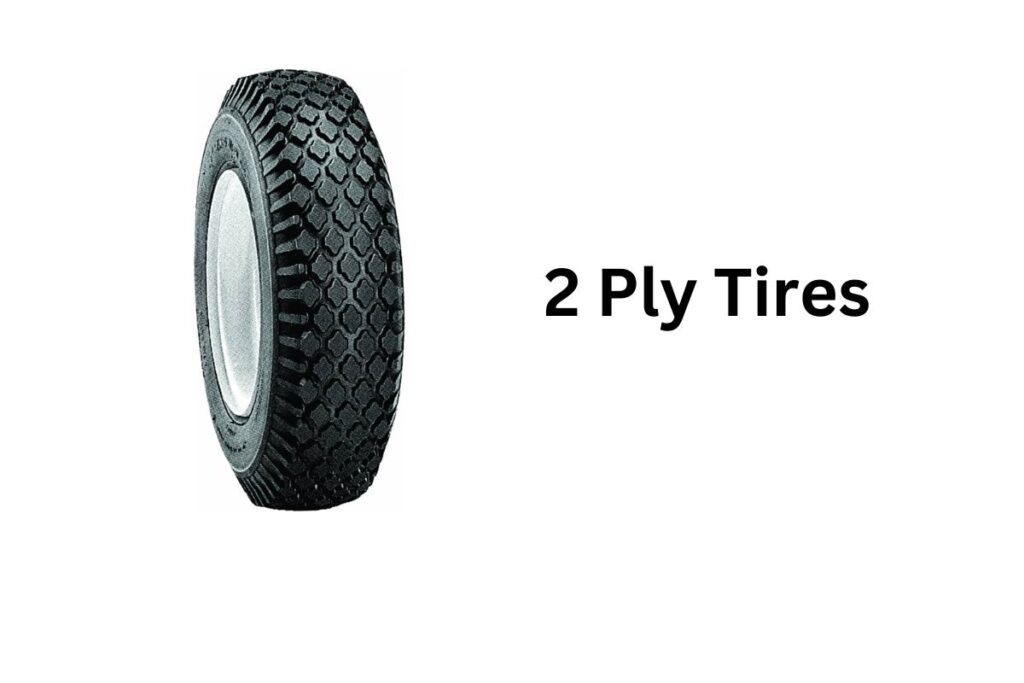Four-ply and two-ply tires differ in durability, performance, and construction.
Four-ply tires are stronger and last longer. They have extra layers.
Meanwhile, two-ply tires are lighter and better for regular roads.
Four-ply tires, with their extra layers, resist punctures and wear. That makes them ideal for heavy vehicles and tough terrains.
Next, we will explore these differences in more detail. This will provide you with a better understanding.

2 Ply Tires Vs 4 Ply Tires: An Overview
Below is a table highlighting the primary distinctions between four-ply and two-ply tires. It’s important to note that variations in differences may occur depending on the tire manufacturer.
| Features | 2 Ply Tires | 4 Ply Tires |
| Strength/Durability | Less Durable | More durable |
| Load Capacity | Since they aren’t as strong or durable, 2 ply tires generally have a lower load capacity. | 4 ply tires tend to have a higher load capacity. |
| Flexibility | 2 ply tires are more flexible | In comparison, 4 ply tires are less flexible |
| Stability and Handling | Lesser stability while driving due to fewer layers. | Better stability and improved handling due to their stronger build. |
| Ride Comfort | They generally provide smooth ride comfort | Less smooth ride compared to 2 ply tires |
| Cost | 2 ply tires are less expensive | 4 ply tires are normally more expensive |
| Fuel Efficiency | 2 ply tires can potentially offer better fuel efficiency. | 4 Ply tires slightly decrease fuel efficiency. |
Strength/Durability
When comparing 2 ply tires and 4 ply tires, think of them like flashlights. More layers or ‘plies’ are akin to adding more batteries. The 2 ply tires have fewer layers, making them not as robust as their 4 ply counterparts. Just like taking a hike in the dark – you’d prefer the flashlight with more batteries for longevity and reliability.
Load Capacity
Consider load capacity as how much weight the tires can handle, similar to backpacks. A 2 ply tire is like a school backpack – suitable for books and lunchboxes, but not ideal for heavy loads. Conversely, a 4 ply tire is akin to a hiking backpack – designed for heavy-duty use.
Flexibility
Two-ply tires, like yoga instructors, bend with the road for a smoother bumpy ride. In contrast, four-ply tires, similar to bodybuilders, are less flexible but stronger. They are great for heavy loads and controlled rides.
Stability and Handling
4-ply tires provide excellent stability and handling at high speeds, just like expert surfers on big waves. However, for moderate speeds or city driving, 2-ply tires work fine. They offer enough stability, similar to casual beach swimmers.
Ride Comfort
With fewer layers, 2 ply tires typically offer more flexibility and smoother rides. It’s akin to choosing between a stiff leather jacket (4 ply) and a soft, comfy hoodie (2 ply).
Cost
More layers usually mean a higher price tag. 4 ply tires tend to be costlier due to the materials and effort involved in their production, while 2 ply tires are usually more budget-friendly.
Fuel Efficiency
2 ply tires are akin to light runners, requiring less energy (or fuel) to perform efficiently. However, heavier 4 ply tires may make your engine work harder due to their weight, slightly impacting fuel efficiency.
Can You Use Them Interchangeably?
Mixing 2 ply and 4 ply tires is technically possible but not recommended. A tire’s ply rating significantly affects its performance. This includes how much weight it can bear, driving stability, and ride comfort.
Using tires with different ply ratings can cause issues. Your ride might become unbalanced, leading to uneven wear and handling problems. It could even create safety risks.
It’s important to follow your vehicle manufacturer’s tire recommendations. If you’re thinking of changing tires, ensure they all have the same ply rating. Consulting a tire expert or mechanic can help you pick the right tires for your vehicle.
Vehicle 2 Ply Tires Vs 4 Ply Tires Will Fit
| Aspect | 2 Ply Tires | 4 Ply Tires |
|---|---|---|
| Suitable for | Lighter vehicles such as sedans and daily commuters | Heavier vehicles like trucks and SUVs |
| Ride Quality | Provides a smoother ride and better fuel efficiency | Offers enhanced durability and load-bearing capacity |
| Performance | May lack durability for off-road or towing purposes | Ideal for off-road adventures or towing tasks |
| Handling | Generally adequate for standard road use | Provides better stability and control, especially off-road |
| Cost | Typically more budget-friendly | Tends to be costlier due to increased durability |
| Recommended Use Cases | Urban driving, regular commuting | Off-road driving, towing, heavy-duty tasks |
| Manufacturer’s Advice | May be suitable according to vehicle specs and recommendations | Often recommended for vehicles with higher load requirements |
Final Lines
Choosing between 2 ply and 4 ply tires depends on your vehicle’s specific requirements.
For lighter vehicles such as sedans and daily commuters, 2 ply tires may be sufficient. They offer a smoother ride and improved fuel efficiency.
However, for heavier vehicles like trucks and SUVs, 4 ply tires are more suitable. They provide enhanced durability and greater load-bearing capacity, making them ideal for off-road excursions or towing tasks.
It’s essential to select tires based on your vehicle’s needs to ensure optimal performance and safety on the road.
